Activity: The Wien Bridge Oscillator
Objective
The objective of this exercise is to understand the operation of a Wien bridge oscillator, including a thorough understanding of the individual components:
Frequency selective feedback network
Gain element
Gain control
Here is a complete video run-through of the experiment, including theory, construction, and measurements:
Background The Wien bridge oscillator was originally developed for telephony applications. The circuits in this exercise are modern adaptations of one described by a Stanford University student, William R. Hewlett,4 in his 1939 masters thesis (see Linear Technology Application Note 43, Appendix C, “The Wien Bridge and Mr. Hewlett”).
Oscillators are circuits that generate periodic waveforms without any input signal. They generally include some form of amplifier stage like transistors or OP-AMPs with a feedback network consisting of passive devices such as resistors, capacitors, or inductors. In order to oscillate, a linear circuit must satisfy the Barkhausen_stability_criterion, which in simple terms states that at the frequency of oscillation:
The loop gain is equal to unity in absolute magnitude The phase shift around the loop is zero or an integer multiple of 2π Consider the first one, and its consequences in an oscillator: If the loop gain is less than unity, the oscillations will die out. If the loop gain is greater than unity, the oscillations will increase in amplitude, either forever (which is possible in a simulation), or until something limits the amplitude (hopefully gracefully, and not as the result of a catastrophic failure.) If the end application is not very sensitive to distortion (output frequencies at multiples of the desired fundamental frequency), then simple gain limiting methods can be employed - this could be as simple as allowing the amplifier output to “clip” at the supply voltage. But if the application requires a pure sine wave, then carefully controlling the amplifier’s gain is absolutely critical. There are various feedback elements employed to generate the required frequency-dependent phase shift - quartz crystals, mechanical resonators, L-C (inductor-capacitor) networks. The Wien_bridge was developed by Max Wien in 1891, as an extension of the Wheatstone_bridge. Whereas the Wheatstone bridge consists of purely resistive elements, the Wien bridge can be used to measure capacitors. While initially intended as a measurement circuit, at balance, the phase shift of a Wien bridge is zero, so including a gain element with a phase shift of zero will satisfy one of the Barkhausen criterion. (It would have been impossible to make an oscillator in 1891 as no linear electronic gain elements existed - the audion tube was invented in 1906.) There are several advantages to using a Wien bridge as the feedback element in an oscillator:
Simplicity Low distortion Either the resistances or capacitances can be adjustable With the phase shift satisfied, the other half of the Barkhausen criterion is a loop gain of unity. At resonance, the reactive arm of the Wien bridge has an attenuation of 1/3, so the amplifier must have a gain of 3. The circuit shown in Figure 1 is a simple Wien bridge oscillator with a 1.0kHz output that illustrates this principle.
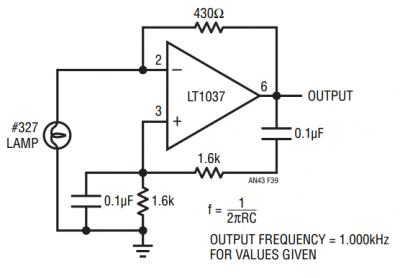
Gain control is achieved with an incandescent light bulb (as it is in Bill Hewlett’s configuration.) An incandescent bulb’s resistance increases with power dissipation, and as a rough rule of thumb the hot resistance is often about 10 times the cold resistance. The #327 lamp shown has an operating voltage of 28V and operating current of 40mA, for a hot resistance of about 700 ohms, and an estimated cold resistance of around 70 ohms. In order to achieve a non inverting gain of 3, the lamp’s resistance must be half of the feedback resistance, or about 215 ohms.
Once the circuit is oscillating, the amplitude control can be described as follows:
If the gain is a little bit less than 3, the lamp cools down, its resistance drops, tending to increase the gain.
If the gain is higher than 3, the lamp heats up, its resistance increases, tending to reduce the gain.
Materials
ADALM2000 (M2K) Active Learning module OR:
Two-channel oscilloscope, signal generator, and / or network analyzer functionality
ADALP2000 Parts Kit Items:
Solderless Breadboard
Jumper Wire Kit
2 – 10nF Capacitor
2 – 1 µF Capacitor
3 – 10 kΩ Resistor
2 – 4.7 kΩ Resistor
1 – 5 kΩ Single-turn potentiometer
2 – 1N4148 Silicon Diode
Directions
Wheatstone Bridge Simulation
In order to become familiar with the operation of a bridge circuit, open the wheatstone_bridge.asc LTspice simulation shown in Figure 2.

Note that the bridge is initially unbalanced, and a small, but nonzero voltage appears at Vcd. (A Voltage-controlled voltage source with a gain of unity is a convenient way to measure the difference between two nodes such that it appears in the simulation results.) Experiment with different values for R3, noting that a value of 10k should balance the bridge and give a zero output. Try reducing R1 and R2 to 1k - does this have any effect on the output voltage?
AC Wien Bridge Simulation
Open the basic_wein_bridge.asc LTspice simulation shown in Figure 3. The simulation is set up as an AC sweep from 100Hz to 10kHz, with the result shown in Figure 4. (Note that a DC bridge supply would produce a fairly predictable output - node C would be at ground potential, and node D would be at 1/3 of the supply.) Run the simulation and probe node C, the output of the reactive arm of the bridge. Notice the “Gentle” hump in response, peaking somewhere slightly less than 2kHz. Probe node Vcd next. Notice the extremely sharp null in response, making it very easy to locate the exact resonant frequency of 1.59kHz.
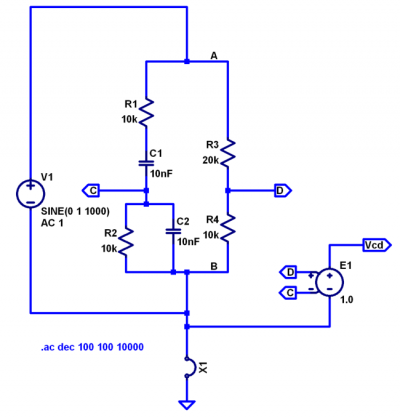
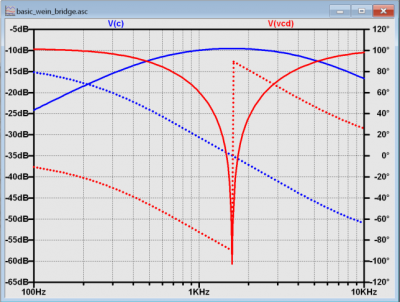
Simulated Wien Bridge Oscillator
Open the wien_bridge_vcvs_gain.asc LTspice simulation shown in Figure 5. This is a circuit that is impossible to build in real-life - the gain stage is essentially perfect - infinite input impedance, zero output impedance, and no offset or gain error. But it allows us to experiment with ideal cases, to gain some intuition into the Barkhausen criterion and test out some assertions made in the background information.
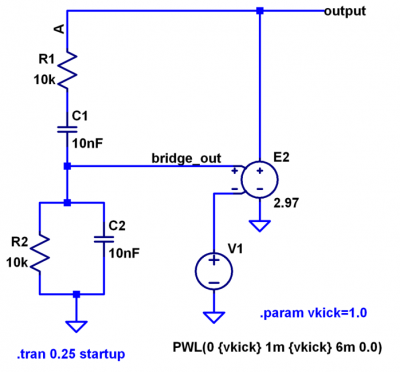
Ignoring V1 for the moment, note that when this simulation is started, all voltages are zero. There is no reason for it to do anything other than stay at zero forever. V1 is there to “kick” the circuit into operation by providing a step to the gain stage when the simulation is first started, then it ramps back to zero and has no further effect on the circuit’s operation. Run the simulation, and probe the output node. Results should look similar to Figure 6.

Note that the circuit oscillates a for a few milliseconds, but the amplitude exponentially decays to zero. This is because the gain is set 1% too low (as you might expect if you built an amplifier with 1% resistors.) Next, set the value for E2 to 2.997, or about 0.1% too low, as shown in Figure 7. Oscillations continue longer, but still decay.
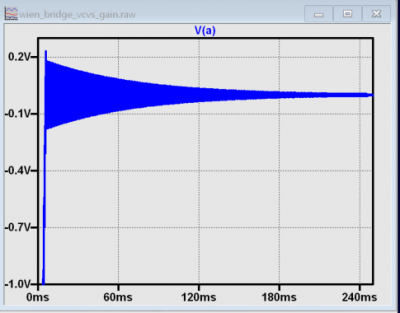
Since we know that the gain needs to be exactly 3 to sustain oscillation, set the gain to 3.0 as shown in Figure 8 and run the simulation.
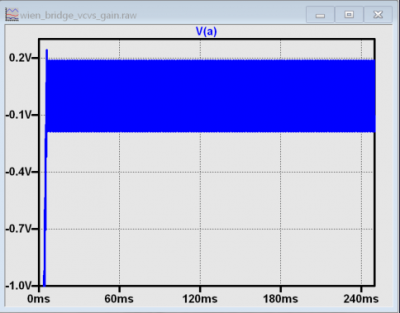
Notice that the operation is exactly as predicted, with a steady amplitude for the entire 250ms simulation time. This would never happen in real life, or even with simulations using a model of a real amplifier - the finite gain, finite input impedance, would cause the gain to be slightly more or less than 3.
As a final illustration that simulations can model situations that would be impossible in the real world, set the gain to 3.03 (1% too high) as shown in Figure 9 and run the simulation.

The output amplitude hits 15 TERAVOLTS after 250ms, with no end in sight. Again, this simulation is only to build intuition about the Barkhausen criterion and has no basis in reality. If you were to build this circuit with an op-amp configured with a gain of 3.03 and powered by +/-5V, oscillations would build until they approached 5V amplitude, then simply “clip” (producing a distorted waveform).
Complete Wien Bridge Oscillator
The circuit shown in Figure 10 is a complete (and practical) Wein bridge oscillator circuit that can be built on a breadboard and run as a simulation (wien_bridge_osc_complete.asc). Rather than using an incandescent bulb (which has a positive coefficient of resistance) for the amplifier’s input resistor, this circuit shunts part of the feedback resistance with diodes, which have a negative coefficient of resistance. Ignoring the diodes, the gain would be 1+(10k+4.7k)/(4.7k+2k)), or about 3.19. But as the voltage across D1 and D2 approaches 600mV or so, the effective resistance of R2 is reduced, dropping the gain.
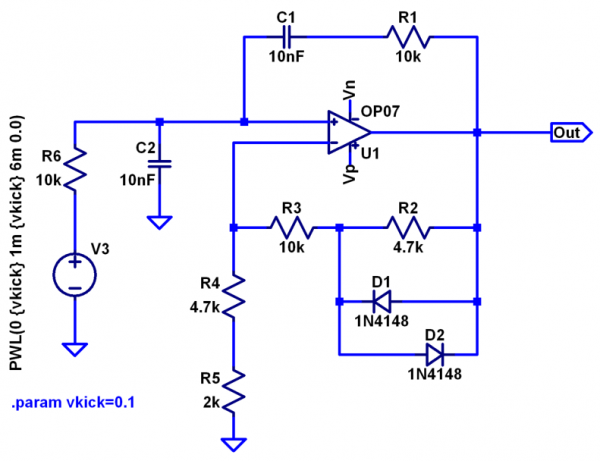
Run the simulation; the output should resemble Figure 11. The “kick” circuit is not necessary to get the simulation to start… eventually. But the amplifier’s offset in the model is quite low, so the kick helps the simulation start up much faster. Startup time is also a concern in some real-world applications, and circuits similar to V3, such as a pulse generator made from logic gates can be employed. Experiment with different values for vkick (including zero).
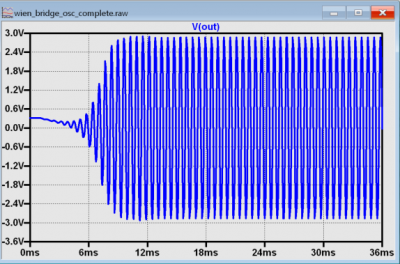
Next, construct the circuit as shown in Figure 12.
To Do: Needs Update - V- not connected
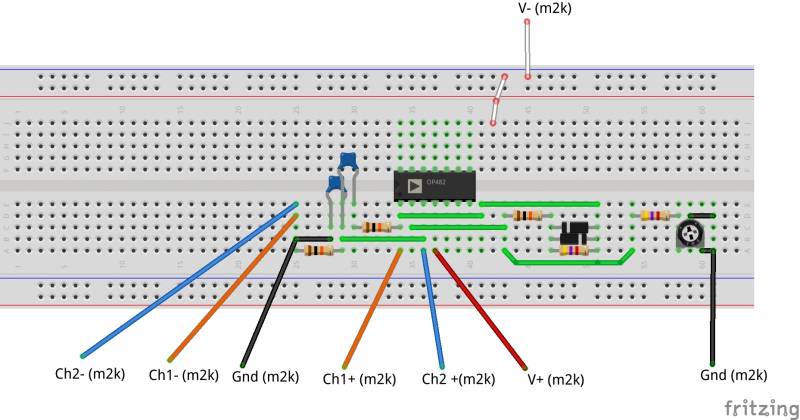
Note that R5 is a potentiometer, allowing the gain of the circuit to be “dialed in” to where oscillation just starts. Measure the output with Scopy’s oscilloscope, results should be similar to Figure 13.
To Do: Take nicer Scopyshot
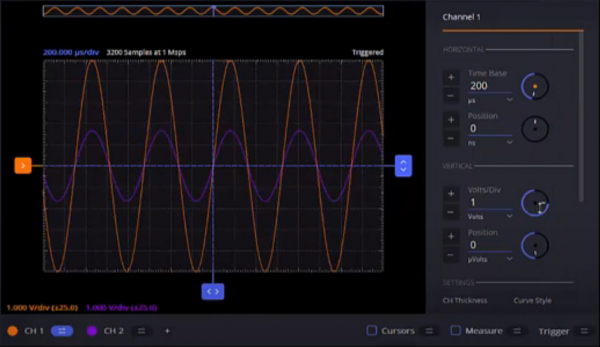
** To Do:** Frequency Domain measurements, Distortion vs. potentiometer setting
Questions:
What is the relationship between the gain control elements and distortion?
- Resources:
Fritzing files: (To Do)
Further Reading
Warning
All the products described on this page include ESD (electrostatic discharge) sensitive devices. Electrostatic charges as high as 4000V readily accumulate on the human body or test equipment and can discharge without detection. Although the boards feature ESD protection circuitry, permanent damage may occur on devices subjected to high-energy electrostatic discharges. Therefore, proper ESD precautions are recommended to avoid performance degradation or loss of functionality. This includes removing static charge on external equipment, cables, or antennas before connecting to the device.